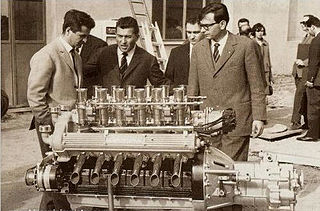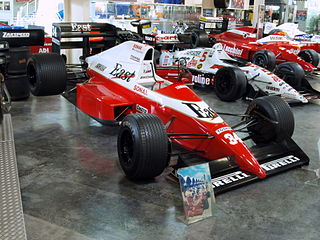The Tyrrell 020 was a Formula One racing car designed by Harvey Postlethwaite and George Ryton for Tyrrell Racing and raced during the 1991 season.
The Tyrrell 020 was a Formula One racing car designed by Harvey Postlethwaite and George Ryton for Tyrrell Racing and raced during the 1991 season.
The 020 was driven by Satoru Nakajima who brought the Honda engine contract with him and also by Stefano Modena. Its best result was a second place by Modena in the Canadian Grand Prix. Tyrrell scored 12 points to finish 6th in the Constructors' Championship with half the points scored by Modena's 2nd in Canada.
The car was powered by the 690 bhp (515 kW; 700 PS) Honda RA101E V10 engine previously raced by McLaren in 1990 and maintained by Mugen Motorsports, which would run Mugen-Honda badged engines the following year for Footwork Arrows.
The car was updated for the 1992 season and was dubbed the 020B. For this season the Honda V10 was replaced with the 680 bhp (507 kW; 689 PS) Ilmor LH10 V10 engine and was driven by Olivier Grouillard and veteran Andrea de Cesaris. The team only scored 8 points for the season but again finished in 6th place.
The 020 was pressed into service again for the first nine races of the 1993 season. Again updated it was called the 020C. For the third time in three years the car ran a V10 engine but this time it carried the 690 bhp (515 kW; 700 PS) Yamaha OX10A. [4] It was driven again by De Cesaris who was joined by Japanese driver Ukyo Katayama. Neither driver would score a World Championship point driving the car.
The Tyrrell 020C was replaced by the 021 midway through the 1993 season.
(key)
| Year | Entrant | Chassis | Engine | Tyres | Drivers | 1 | 2 | 3 | 4 | 5 | 6 | 7 | 8 | 9 | 10 | 11 | 12 | 13 | 14 | 15 | 16 | Points | WCC |
|---|---|---|---|---|---|---|---|---|---|---|---|---|---|---|---|---|---|---|---|---|---|---|---|
| 1991 | Braun Tyrrell Honda | Tyrrell 020 | Honda RA101E V10 | P | USA | BRA | SMR | MON | CAN | MEX | FRA | GBR | GER | HUN | BEL | ITA | POR | ESP | JPN | AUS | 12 | 6th | |
| | 5 | Ret | Ret | Ret | 10 | 12 | Ret | 8 | Ret | 15 | Ret | Ret | 13 | 17 | Ret | Ret | |||||||
| | 4 | Ret | Ret | Ret | 2 | 11 | Ret | 7 | 13 | 12 | Ret | Ret | Ret | 16 | 6 | 10 | |||||||
| 1992 | Tyrrell Racing Organisation | Tyrrell 020B | Ilmor LH10 V10 | G | RSA | MEX | BRA | ESP | SMR | MON | CAN | FRA | GBR | GER | HUN | BEL | ITA | POR | JPN | AUS | 8 | 6th | |
| | Ret | Ret | Ret | Ret | 8 | Ret | 12 | 11 | 11 | Ret | Ret | Ret | Ret | Ret | Ret | Ret | |||||||
| | Ret | 5 | Ret | Ret | 14 | Ret | 5 | Ret | Ret | Ret | 8 | 8 | 6 | 9 | 4 | Ret | |||||||
| 1993 | Tyrrell Racing Organisation | Tyrrell 020C | Yamaha OX10A V10 | G | RSA | BRA | EUR | SMR | ESP | MON | CAN | FRA | GBR | GER | HUN | BEL | ITA | POR | JPN | AUS | 0 | NC | |
| | Ret | Ret | Ret | Ret | Ret | Ret | 17 | Ret | 13 | ||||||||||||||
| | Ret | Ret | Ret | Ret | DSQ | 10 | Ret | 15 |

The 1988 Australian Grand Prix was a Formula One motor race held at the Adelaide Street Circuit on 13 November 1988. It was the sixteenth and final race of the 1988 Formula One World Championship, and the last race for which turbocharged engines would be eligible until the 2014 Australian Grand Prix.

The 1992 Australian Grand Prix was a Formula One motor race held at Adelaide on 8 November 1992. It was the sixteenth and final race of the 1992 Formula One World Championship.

The 1989 FIA Formula One World Championship was the 43rd season of FIA Formula One motor racing. It began on 26 March and ended on 5 November. Alain Prost won his third Drivers' Championship, and McLaren won the Constructors' Championship.
Motori Moderni was a Formula One engine manufacturer from 1985 through 1987. It was established in Novara by Italian engine designer Carlo Chiti.

The Lamborghini V12 refers to the flagship V12 engine used by Lamborghini. Lamborghini has had two generations of V12 engines through their history, both of which were developed in-house. The first-generation Lamborghini V12 was a sixty degree (60°) V12 petrol engine designed by Lamborghini, and was the first internal combustion engine ever produced by the firm.

The McLaren MP4/6 is a successful Formula One racing car designed by McLaren's Neil Oatley, Matthew Jeffreys, David North, David Neilson, Bob Bell and Mike Gascoyne; powered by the Honda RA121E V12 engine for use in the 1991 Formula One season, with the engine's design and development led by Osamu Goto. It was driven by reigning World Champion, Brazilian Ayrton Senna, and Austria's Gerhard Berger. Ayrton Senna would win his third World Championship in the MP4/6. The MP4/6 was notable for being the last F1 car to win the championship with a manual gearbox and the only F1 car powered by a V12 engine to do so.

The McLaren MP4/8 was the Formula One car with which the McLaren team competed in the 1993 Formula One World Championship. The car was designed by Neil Oatley around advanced electronics technology; including a semi-automatic transmission, active suspension, two-way telemetry, and traction control systems, that were developed in conjunction with McLaren shareholder Techniques d'Avant Garde (TAG). It was powered by the 3.5-litre Ford HBD7 V8 engine and was the first McLaren to feature barge boards. The McLaren MP4/8 was also first Ford-powered McLaren car since McLaren MP4/1C in 1983.

The Ferrari 641 was the Formula One racing car with which the Ferrari team competed in the 1990 Formula One World Championship. Driven by Alain Prost and Nigel Mansell, it won six Grands Prix.

The McLaren MP4/9 was a Formula One car designed by Neil Oatley and used by the McLaren team in the 1994 Formula One World Championship. The number 7 car was driven by Finn Mika Häkkinen, in his first full season with the team, while the number 8 car was driven by Briton Martin Brundle, who had signed from Ligier. Frenchman Philippe Alliot deputised in the number 7 car at the Hungarian Grand Prix when Häkkinen was banned from driving in this race. For the 21st consecutive year, Marlboro was the team's title sponsor, with additional sponsorship from Hugo Boss, Shell and Goodyear. The MP4/9 was the first and only McLaren F1 car to utilise Peugeot engines.
This article gives an outline of Formula One engines, also called Formula One power units since the hybrid era starting in 2014. Since its inception in 1947, Formula One has used a variety of engine regulations. Formulae limiting engine capacity had been used in Grand Prix racing on a regular basis since after World War I. The engine formulae are divided according to era.

The Williams FW12 was a Formula One racing car used by the Williams team for the 1988 season. An updated version, the FW12C, was used for 12 of the 16 races of the 1989 season. The FW12 was Williams's first naturally aspirated car since the FW08 and FW08C used in the 1982 and 1983 season.

The Benetton B190 is a Formula One racing car designed by Rory Byrne in collaboration with Benetton's Technical Director, John Barnard, a designer with experience at racing companies McLaren and Ferrari and arguably the most successful Formula One designer of the 1980s with his cars winning 31 races since 1981. Geoff Goddard, chief designer at Cosworth was responsible for designing the car's engine, which was of exclusive use for Benetton. The B190 was raced by Benetton in all but the first two races of the 1990 Formula One season.

The Lola THL2 was a Formula One racing car designed by Neil Oatley for FORCE and was used by Team Haas (USA) Ltd. during the 1986 Formula One season. Two of the FORCE aerodynamicists who worked on the car during its countless hours of Wind tunnel testing were a young Ross Brawn and Adrian Newey. The car debuted at the 1986 San Marino Grand Prix and was driven by 1980 World Drivers' Champion Alan Jones from Australia, and his new teammate Patrick Tambay of France.

The Zakspeed 891 was a Formula One car for the 1989 season run by the German Zakspeed team. Its drivers were German Bernd Schneider in his second year with the team and F1 rookie Aguri Suzuki from Japan. The car was powered by F1 newcomer Yamaha who had produced the OX88 V8 engine for exclusive use by Zakspeed in Formula One.

The Tyrrell 021 was a Formula One racing car designed by Mike Coughlan for Tyrrell Racing and raced during the 1993 season. The car was powered by a Yamaha V10 engine and was driven by Ukyo Katayama and Andrea de Cesaris. The car was unsuccessful with no points scored during the season. The 021 was replaced by the Harvey Postlethwaite designed 022 for the 1994 season.

The Lola LC90 was a Formula One car designed by Eric Broadley and Chris Murphy for use in the 1990 Formula One season by the Larrousse team. It was powered by the 3.5L Lamborghini LE3512 V12 engine. The car was driven by Japanese driver Aguri Suzuki who had spent 1989 failing to pre-qualify all 16 races for Zakspeed, and Frenchman Éric Bernard.

The RA series of 3.5-litre and 3.0-litre, naturally-aspirated, V10 racing engines were made by Honda to compete in Formula One racing; between 1989 and 1990, and then again between 2000 and 2005. Between 1992 and 2000, the engines were also made by Mugen Honda. The customer engines were used by McLaren, Arrows, Lotus, Ligier, Tyrrell, Prost, and Jordan.

The Lamborghini LE3512 was a naturally-aspirated V12 motor racing engine, designed and developed by Lamborghini, to compete in Formula One. The engine was raced between 1989 and 1993.

Ferrari has made a number of V12 racing engines designed for Formula One; made between 1950 and 1995. Some derived engines were also used in various Ferrari sports prototype race cars and production road cars.

The Peugeot V10 engine is a series of naturally-aspirated, V10, racing engines; produced between 1990 and 2000. These engines were used to compete in the World Sportscar Championship, between 1990 and 1993, with Peugeot winning the 24 Hours of Le Mans two years in a row. In 1994, they decided to make the switch to Formula One, using the same 3.5 L V10 derived from their highly successful, Le Mans-winning 905 Group C sports prototype, that was easily adjusted to F1 regulations. Peugeot debuted as an engine supplier with the McLaren team and remained in F1 until the end of the 2000 season.